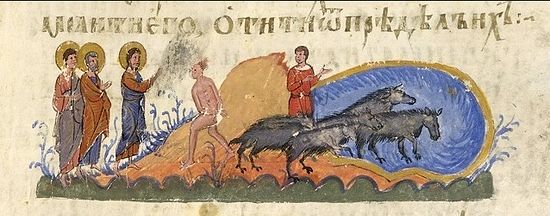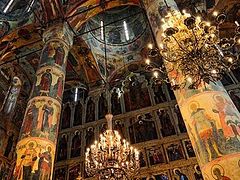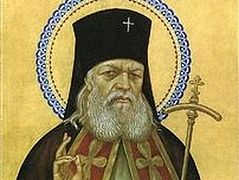Source: Second Terrace
March 21, 2016
What does "triumph" mean, today when we think about the "Triumph of Orthodoxy"?
Three years ago, my students give me a gift at the end of the Spring Semester. No, it wasn’t an icon of Maximus the Confessor or Gregory of Nysa, which would have made sense. It was a wooden shingle with these words emblazoned upon it: “It is what it is.”
There is a story behind this odd gift. My students learn very soon that certain phrases are discouraged in my classroom — phrases like “Whatever” … or “I can’t help it” … or especially, “It is what it is.” The sign was a comic souvenir of my opposition to this common phrase.
I will tell you why I protest this phrase. It obscures the fact that things should not be the way they are.
There is a lot that happens in reality that is not God’s Will. There is a reason why we pray “Thy Kingdom come, Thy Will be done.” And that reason is simply because there is a lot of stuff that goes on that is certainly not God’s Will. When evil happens, when people get hurt, when the innocent suffer -- this is not the work of God Who tells us that “He is Love,” and that in Him there is no darkness or turning, and that He is only the giver of all good gifts.
So we do not have to accept that the way things are is the way things really are. We can confidently say that this world where there is so much violence and ugliness doesn’t have to be that way. It is okay to think that things ought to be better. Actually, the very fact that we are even aware that there is something wrong is proof that we have a soul. Only an eternal soul would make it possible for us to know about a better world, about a better arrangement of things, and about a beautiful world that is to come.
In fact, that very impatience should move us to pray, with deep emotion, “Thy Kingdom come, Thy Will be done.”
Because God’s reality is much, much better than the reality we’ve become so used to. We call this divine “reality” the Kingdom of God, which is the Personal Presence of Jesus Christ. And the “view” of that reality is truth.
This brings me back to why today is so important. When we celebrate the Triumph of Orthodoxy today, we rejoice in this “view,” a “new vision” that the Fathers call “theoria.” It is a vision of the world as Creation in the light of the Risen Lord Jesus Christ. It is a vision of the way things really are and are meant to be.
“Thus we preach our true Christ our true God and honor His saints in words, in writings, in thoughts, in liturgy, in churches, in icons …” So we say, confidently, in the Synodikon after the procession.
This new vision is the light of Christ. We preach this vision of a reality that is very, very different from what we’ve been told in the world. We’ve grown up hearing — and we continue to hear — that reality is what you can see, touch, smell or hear and there is nothing else … we are told that everything can be explained by science and math … we are told that all problems can be solved by the right technology, or by a politician or party …
… in sum, we are told that the best way to get by in life is to accept that, you know, “it is what it is.”
No. It most assuredly is not. If you stick with only science or math, you wouldn’t even be able to say that something is beautiful, despite the fact that you know that beauty is all around you in Creation. All the technology and politics in the world cannot explain how you think thoughts and how you feel emotions … or how you love … or how you even know that you’re alive.
Years ago — like seventeen hundred years ago, before Constantine legalized Christianity — the Orthodox Church educated people for three years before they were baptized. During this “catechumenate” time of preparation, they learned the Creed so they could recite it at baptism. They learned doctrine. They were taught how to struggle against the passions of pride, anger, lust and greed. They practiced the virtues of charity and hospitality.
Why so long? Because healing, while it is beautiful, is neither easy nor comfortable. Because it takes a while to go from “knowing information” tobelieving. After all, it took the Apostles three years to make this transition from “fact” to “truth.” Memorizing a bunch of facts is not going to make much difference.
The Church did this three year catechumenate for good reason. They knew then — probably better than it does now — that Orthodox doctrine is the most important education that a person could get. It is more important than science, math, technology and politics put together. The Church knew, indeed, that “this is the Faith of the Orthodox, this is the Faith that has established the Universe” — human science doesn’t establish the Universe, nor does math, nor -- most certainly -- politics. The Orthodox Faith establishes the Universe. It especially establishes the human heart, and the human mind.
It is very interesting what the Church called those teachers of these older teenagers and adults during this three-year process. Today, we call them “catechists” or “Sunday School teachers.” But in the first five hundred years of the Church, these teachers were most frequently called “exorcists.”
And why? At the beginning of this three-year education, prayers of exorcism were prayed over the catechumens — the very same prayers we pray today at the beginning of the Baptism service. These same people that prayed these prayers were the instructors for the next three years. There is no better way to fight off a passion or a demon than through learning and “living out” Orthodox truth — which is the vision of Christ that makes all things new.
I think this makes a lot of sense. I know, from personal and professional experience as a psychotherapist, how toxic passion can be. We live in a culture today that suffers from an epidemic of anger and despair. But I also know that this darkness can be cleansed by hearing just what those catechumens heard, seventeen hundred years ago, listening to an exorcist gently leading them to a new, brighter vision.
This long education that is also an extended exorcism started with happy news: at the deepest level of reality, at the very basis of existence is the fact of Divine Love — not chaos and violence. God Himself is Trinity: a totally united Friendship of Three Persons, constantly pouring out themselves to each other in infinite love.
With that same outpouring of love, God creates the world in peace and beauty.
He makes man and woman in His own image: they are able to receive His love as a free gift … they are also able to freely refuse it.
Everything in Creation clearly revealed God’s personality as Love, and Adam and Eve could clearly see this. God planted, deeply within the human heart, a way to see Him and a desire to reflect His light.
In every work of Creation, the Father is the Creator, the Son is the Artist, and the Spirit is the Finisher. And in everything — from every blade of grass to every mountain, from every little animal to the ocean and the stars — Christ has designed Creation to prove His love for you, and to draw you, in deep desire, to communion with Him in friendship.
In all of this, God pours out Himself to us — and when we refused this divine, Personal gift of love when we desired sin instead, then God poured out Himself even more.
And that “something even more” took the shape of the Cross … when the Artist of all creation was raised up to the sky on Good Friday, when, by His passion and death, the cancer of sin was stopped.
When Christ descended into Hell on Holy Saturday, He destroyed the power of death in the explosion of the revelation of His divine glory.
Then, forty days later, He ascended into heaven and took our humanity with Him.
The catechumens were taught that in Baptism, they actually joined this beautiful, joyous story. They discovered that they could really enter this new Vision. They were taught that when they received the Eucharist, they were truly participating in the divine nature of Christ and experiencing the light and peace of the Resurrection, even now …
… whenever I get “down” from listening to too much news, I go back to this New Vision of the way things really are in Christ, and I work hard to believe better, and believe more. And the more I believe, through learning and prayer and fasting, the more I am liberated from those dark shadows of anger and despair.
I think this will work for you, too. You can’t stop learning about Holy Tradition when you finish First Confession class, or when you leave Sunday School at seventeen. The older you get, the more you need Orthodox doctrine to save your life, and to keep you sane.
There is a strong relationship between doctrine and sanity, between perceiving this New Vision and experiencing “the peace that passes all understanding.” Look at the saints in the icons that we celebrate today. Their faces show not a trace of despair or worry, anger or greed. There is only peace, clarity, balance, confidence and hope.
Do you remember the story of the poor man who was possessed by a thousand demons, who wore broken chains clanging from his wrists and crawled around naked amongst the tombstones? He — the Gadarene Demoniac — looked the complete opposite of the saints: no peace, no hope, only fear and rage.
Remember how even the pigs had more sense than humans. Only humans choose to tolerate the presence of demons. The pigs were so revolted by the presence of demons that they did the only thing they could: they jumped off a cliff, because they couldn’t stand the stench of demon filth.
I like to think that this poor man represents the world of “it is what it is” — a world that’s gone stark raving mad with anger, pride, greed, lust and despair, a world polluted with the stench of demons.
Remember what happened? The only thing that could help was a New Vision of the way things God means them to be: and that Vision was, and is, the Presence of Jesus Christ Himself.
It is a beautiful thing that when all the people came to find out what happened, they saw this man, but he was completely changed.
The chains were off. He was wearing clothes. His hair was combed, his body was washed and clean.
The Gospel says that the townspeople found him “in his right mind.” And it showed on his face. It was peace. It was hope. It was clear and sane. For the first time, the eyes were bright and a smile of hope beamed from his face.
He had met God, and found the True Friend.
This is the Triumph of Orthodoxy. This is what happens every time when we turn away from a mad world of “it is what it is,” and turn instead, in the truth of Orthodoxy, to the Vision of Christ, full of grace and peace.




